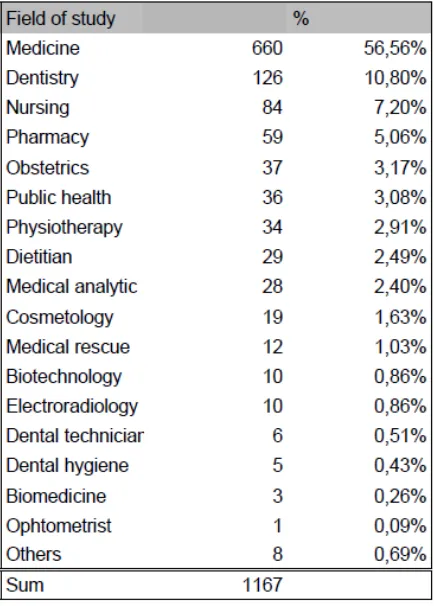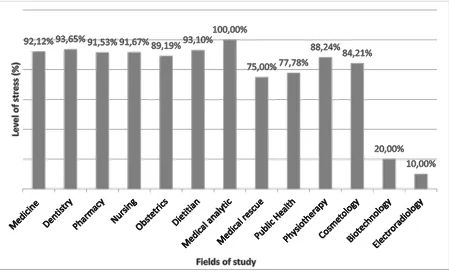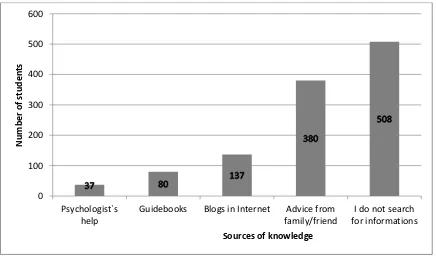Brożyna Klaudia, Radzka Agnieszka, Tkaczyk Jędrzej, Ciechański Krystian, Piecewicz-Szczęsna Halina. Stress among medical
students in Poland. Journal of Education, Health and Sport. 2018;8(8):171-179. eISNN 2391-8306. DOI
http://dx.doi.org/10.5281/zenodo.1304266
http://ojs.ukw.edu.pl/index.php/johs/article/view/5625
The journal has had 7 points in Ministry of Science and Higher Education parametric evaluation. Part B item 1223 (26/01/2017). 1223 Journal of Education, Health and Sport eISSN 2391-8306 7
© The Authors 2018;
This article is published with open access at Licensee Open Journal Systems of Kazimierz Wielki University in Bydgoszcz, Poland
Open Access. This article is distributed under the terms of the Creative Commons Attribution Noncommercial License which permits any noncommercial use, distribution, and reproduction in any medium, provided the original author (s) and source are credited. This is an open access article licensed under the terms of the Creative Commons Attribution Non commercial license Share alike.
(http://creativecommons.org/licenses/by-nc-sa/4.0/) which permits unrestricted, non commercial use, distribution and reproduction in any medium, provided the work is properly cited. The authors declare that there is no conflict of interests regarding the publication of this paper.
Received: 05.06.2018. Revised: 28.06.2018. Accepted: 03.07.2018.
Stress among medical students in Poland
Klaudia Brożyna, Agnieszka Radzka, Jędrzej Tkaczyk,
Krystian Ciechański, Halina Piecewicz-Szczęsna
Chair and Department of Epidemiology and Clinical Research Methodology, Medical University of Lublin
Corresponding author: Halina Piecewicz-Szczęsna, e-mail: h.piecewicz@umlub.pl
ORICID ID:
Klaudia Brożyna: https://orcid.org/0000-0003-4313-1353 Agnieszka Radzka: https://orcid.org/0000-0002-3484-4602 Jędrzej Tkaczyk: https://orcid.org/0000-0003-2080-7525 Krystian Ciechański: https://orcid.org/0000-0003-1099-3520 Halina Piecewicz-Szczęsna http://orcid.org/0000-0002-0573-7226
Abstract
Stress is a common problem among students from medical faculties. There is no doubt that stress is an inseparable companion during not only studies, but also after degree while working as a professional. For that reason it is necessary to encourage young people to find their own effective manner to cope with stress.
Abstrakt
Bez wątpienia stres jest związany z codziennym, studenckim życiem. Uniwersytety Medyczne są jednymi z tych środowisk, które są związane z negatywnym wpływem stresu na wiele dziedzin życia takich jak zdrowie psychiczne, wyniki w nauce oraz nastrój. Celem pracy jest analiza występowania stresu wśród studentów różnych kierunków na Uniwersytetach Medycznych w Polsce. W związku z tym, przeprowadzono anonimową ankietę, która zawierała 23 pytania i została rozpowszechniona przez Internet. Stres jest częstym problemem wśród studentów kierunków medycznych. Nie ulega wątpliwości, że stres jest nieodłącznym towarzyszem podczas nie tylko studiów, ale także po ukończeniu studiów w trakcie pracy zawodowej. Z tego powodu konieczne jest zachęcanie młodych ludzi do znalezienia własnego skutecznego sposobu radzenia sobie ze stresem.
Background
There is no doubt that stress is bonded with daily routine of students. Medical colleges are one of these environments, which are associated with negative impact of stress on many fields of life like physical health, academic feedback and physiological mood of student`s [1]. Stress has a different meaning among various people in varied situations. The first appropriate definition of stress was defined by Hans Selye, Canadian doctor [2]. He considered that stress is the non-characteristic neuroendocrine reaction of the body [3]. Selye revealed that stress is a result of "stressors", which may be physical like changes in external temperature, chemical or psychological [4]. It is known that, hormones play the most important role in pathophysiology of stress reaction. Mainly the cateholamines and the glucocortycoids initialize changes in cells and tissues, which help to get through the stress [5]. We can distinguish two types of stress reaction on grounds of duration ; acute and chronic. First one is when the response takes place right after the stressor and is time-bound. Second one describes situation, when the exposure to stressors is prolonged [6].
Aim of study
Material and method
The questionnaire contained 23 questions, both one-time and multiple choice. The survey was widespread via Internet among students from various Medical Universities in Poland. The reached data were evolved by Microsoft Excel.
Results
[image:3.595.189.406.346.649.2]In the survey took part 1167 responders, the mean age was 22,28 (19-35), SD= ± 2,09. Males were 243 (20,8%) and females were represented by 924 (79,2%) interviewees. In the questionnaire answered students from different fields of study (Table 1). The most frequent degree courses were medicine (56,58%), dentistry (10,80%) and pharmacy (7,20%). The most often were students from II (22,7%) and IV (23,22%) year of study (Table 2.)
Table 2. Years of study among responders
Fig. 1. Comparison between field of study and level of stress among students
Fig. 2. Frequency of stress among students.
The most stressful situations during studies chosen by interviewees are oral exam (79,8%), failing exam (76,5%), expressing own opinion in front of group (40,5%), exam with open questions (38%). The multiple choice question " Did you experience side effects of stress and what was that ?" showed that the most frequent answers were: feel irritated and
Number of students
Fr
e
q
u
e
n
cy
o
f str
e
[image:5.595.74.523.94.366.2]have dropped of frame of mind - 834 (71,5%), have problems with concentration – 585 (50,1%) and insomnia – 511 (43,8%) (Fig.3). For the multiple choice question about manners to overcome stress, the most popular answers among students were: conversation with family/friend - 788 (67,7%), sleeping –734 (63,1%), physical activity 691 (59,4%) (Fig.4). In another question about effectiveness of methods used by responders, 327 (28,1%) of them claimed that manner is always working and reducing the level of stress. Nonetheless, vast majority answered that method sometimes works – 766 (65,9%).When asked about sources of knowledge about how to manage stress, most of the students – 508 (43,5%) claimed that they do not search information how to deal with stress in which 74% were woman and 26% were man, which is not statistically significant (p=1,77). 380 (32,6%) of responders chose "advice from family and friends" and 137 (11,7%) elected "Blogs in Internet" (Fig. 5).
Fig. 3. Side effects of stress among medical students
0 200 400 600 800 1000 1200
Problems with concentration
Constipation Insomnia Feel irritated and have drop
of frame of mind
Neurosis Depression
N
u
m
b
e
r
o
f stu
d
e
n
ts
Fig. 4. Ways to overcome stress among medical students.
Fig.5. Sources of knowledge about how to manage stress
0 100 200 300 400 500 600 700 800 900 N u m b e r o f stu d e n ts
Different ways to manage stress
0 100 200 300 400 500 600 Psychologist`s help
Guidebooks Blogs in Internet Advice from family/friend
I do not search for informations N u m b e r o f stu d e n ts
[image:7.595.73.509.448.705.2]Discussion
Stress among medical students is a common phenomen, most of the students in this survey feel stressed during academic year. That can have a big influence on efficiency of their work in the future and quality of private life [7]. The problem of psychological disorders such stress or depression among students from medical universities are still not treated seriously and properly [8]. In many scientific works, exams are mentioned as a dominant stressor [9]. In some of them not only participating in exams are stressful but also the frequency of test in semester or year [9,10,11]. In many scientific works it is said that females are more often stressed than males[11,12]. According to this survey and other articles, the most common symptoms or side effects of stress are lack of happiness, problems with sleeping (insomnia), losing self-confidence or problems with concentration [1,13]. It is known that the high level of stress can cause both somatic and mental disorders in the future [4]. In Indian studies more than 48% of medical students had depression symptoms [14]. Moreover, according to survey from Pakistan almost 44% of responders from Medical Universities showed similar signs [15]. Probably the earliest is the stress reduced, the lowest is the risk of depression [16]. As well in our scientific work as in other articles, physical activities, conversation with friends and listening to music are known as activities which relieve stress. The difference is that in other surveys listening to music is known as a most popular way to manage stress (33,08%) while in our survey the most common is conversation with family or friend [17].
Conclusion
The study reveals that stress is a common problem among students from medical faculties. There is no doubt that stress is an inseparable companion during not only studies, but also after degree while working as a professional. For that reason it is necessary to encourage young people to find their own effective manner to cope with stress. Moreover, it is essential to make students aware of first signs of depression and burnout, because it will ensure their both personal and professional life.
References
1. Sherina MS, Rampal L, Kaneson N. Psychological Stress Among Undergraduate Medical Students. The medical Journal of Malaysia.2004;59(2).
2. Selye H. Forty years of stress research: principal remaining problems and misconceptions. Canadian Medical Association Journal. 1976;115(1):53-56.
3. Sandor Szabo, Yvette Tache, & Arpad Somogyi, The legacy of Hans Selye and the origins of stress research: A retrospective 75 years after his landmark brief “Letter” to the Editor# of Nature Stress, September 2012; 15(5): 472–478 q Informa Healthcare USA, Inc. ISSN 1025-3890
4. Selye H. 1956. The stress of life. New York: McGraw-Hill Book Co.
Me‘decine et de ChimrgieExpe’rimentales Current Researches in Anesthesia and Analgesia-May- June, 1956
6. Pacak, Karel, and Richard McCarty. "Acute stress response: experimental." Encyclopedia of stress 1 (2000): 8-17.
7. Ko SM, Kua EH, Fones CSL. Stress and the Undergraduates. Singapore MedJ 1999; 40(10): 627-30
8. Tyssen R, Vaglum P, Gronvold NT, Ekeberg O. Suicidal ideation among medical students and young physicians: a nationwide and prospective study of prevalence and predictors. Journal of AffectiveDisorders 2001; 64(1): 69- 79.
9. Gazzaz ZJ, Baig M, Al Alhendi BSM, et al. Perceived stress, reasons for and sources
of stress among medical students at Rabigh Medical College, King Abdulaziz
University, Jeddah, Saudi Arabia. BMCMedicalEducation. 2018;18:29.
doi:10.1186/s12909-018-1133-2.
10. Shah M, Hasan S, Malik S, Sreeramareddy CT. Perceived Stress, Sources and Severity of Stress among medical undergraduates in a Pakistani Medical School. BMC MedicalEducation. 2010;10:2. doi:10.1186/1472-6920-10-2.
11. Sreedevi A, Rao GV, Bharath P, Reddy K, Parigala R, Pappu S, Chowdary S, Parem S. Study on stress among first-year medical students of Kurnool Medical College, Kurnool. Int J MedSci Public Health 2016;5:852-855
12. Sharma, Balkishan&Wavare, Rajshekhar. (2013). academic stress due to depression among medical and para-medical students in an Indian Medical College: health initiatives cross sectional study. Journal of Health Sciences (J o H Ss). 3. 29-38. 13. WolfTM, Kissling GE. Changes in life-style characteristics, health and mood of
freshman medical students. J MedEdu 1984; 59: 806-14
14. Kumar SG, Kattimani S, Sarkar S, Kar SS. Prevalence of depression and its relation to stress level among medical students in Puducherry, India. Industrial Psychiatry Journal. 2017;26(1):86-90.
15. Jadoon NA, Yaqoob R, Raza A, Shehzad MA, Zeshan SC. Anxiety and depression among medical students: A cross-sectional study. J Pak MedAssoc. 2010;60:699–702. 16. Bostanci M, Ozdel O, Oguzhanoglu NK, Ozdel L, Ergin A, Ergin N, et al. Depressive symptomatology among university students in Denizli, Turkey: Prevalence and sociodemographic correlates. CroatMed J. 2005;46:96–100.



